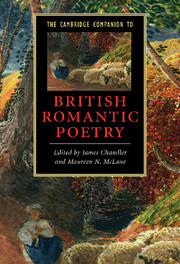Book contents
- Frontmatter
- Introduction: The companionable forms of Romantic poetry
- 1 The living pantheon of poets in 1820: pantheon or canon?
- 2 Romantic poetry and antiquity
- 3 Romantic meter and form
- 4 Romantic poetry and the standardization of English
- 5 Thinking in verse
- 6 Romantic poetry and the romantic novel
- 7 Wordsworth’s great Ode: Romanticism and the progress of poetry
- 8 Romantic poetry, sexuality, gender
- 9 Poetry, peripheries and empire
- 10 Romantic poetry and the science of nostalgia
- 11 Rethinking Romantic poetry and history: lyric resistance, lyric seduction
- 12 The medium of Romantic poetry
- 13 Romantic poets and contemporary poetry
- Index
- Series List
8 - Romantic poetry, sexuality, gender
Published online by Cambridge University Press: 28 November 2008
- Frontmatter
- Introduction: The companionable forms of Romantic poetry
- 1 The living pantheon of poets in 1820: pantheon or canon?
- 2 Romantic poetry and antiquity
- 3 Romantic meter and form
- 4 Romantic poetry and the standardization of English
- 5 Thinking in verse
- 6 Romantic poetry and the romantic novel
- 7 Wordsworth’s great Ode: Romanticism and the progress of poetry
- 8 Romantic poetry, sexuality, gender
- 9 Poetry, peripheries and empire
- 10 Romantic poetry and the science of nostalgia
- 11 Rethinking Romantic poetry and history: lyric resistance, lyric seduction
- 12 The medium of Romantic poetry
- 13 Romantic poets and contemporary poetry
- Index
- Series List
Summary
The herald, companion, and follower of an “affective revolution” as significant to modernity as its accompanying political revolutions, Romanticism is deeply concerned with questions of sexuality and gender. In its lyric intensity, introspection, powerful emotions, and luxuriant language, Romantic poetry has played a critical role in our enduring notions of poetry as expressive of a deep self. Sexuality, and the self-knowledge and liberation that sexuality seems to promise, are central to this expressive hypothesis associated with Romantic poetry. We are familiar with readings of canonical Romantics that emphasize their celebrations of politicized sexual liberty; building on this work, I would like to broaden the spectrum of poets considered, and most importantly, to engage with the emerging consensus in the history of sexualities. Approaching the question of Romantic poetry's relationship to sexuality and gender in more historically charged ways allows us to consider how categories of sexuality and gender operate through both content and form - as significant to the intellectual and aesthetic work of the poetry as to the material and commercial properties of poetic production.
The revolutionary fervor of late eighteenth-century Europe destabilized both gender and sexual roles in unprecedented ways, unleashing at once widespread demands for greater social and gender mobility and a reactionary backlash that sought to reinforce hierarchies. Domestic and sexual roles were of particular concern to reactionary British moralists, as it was through such seemingly private channels that dangerous political temptations could corrupt the body politic.
- Type
- Chapter
- Information
- The Cambridge Companion to British Romantic Poetry , pp. 155 - 177Publisher: Cambridge University PressPrint publication year: 2008
- 3
- Cited by

